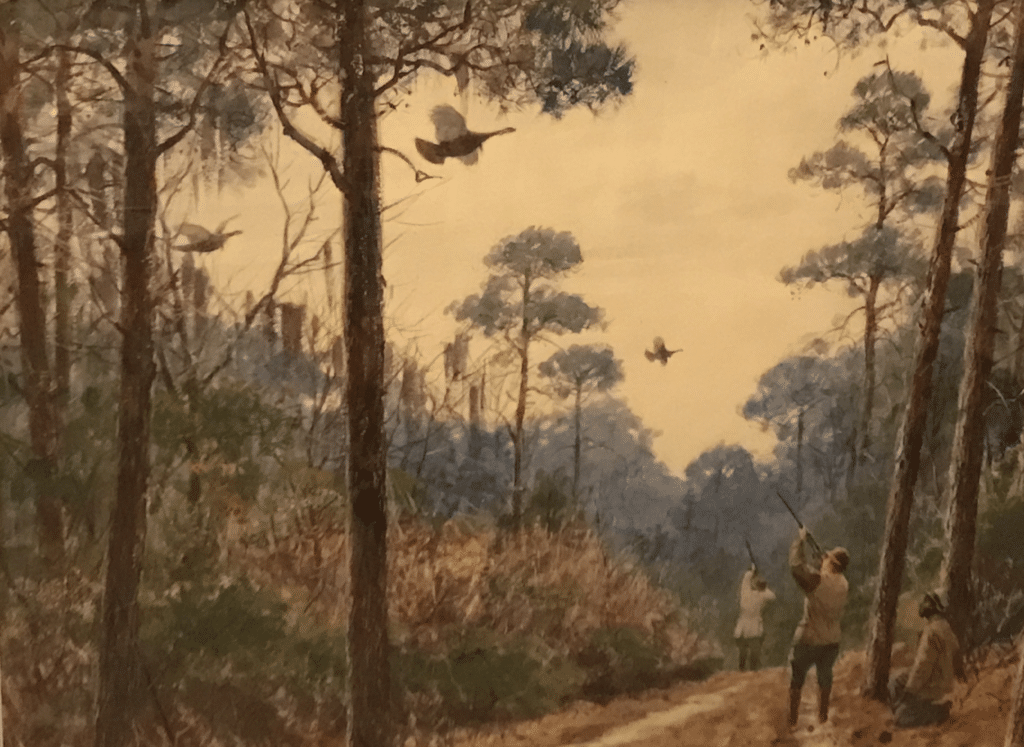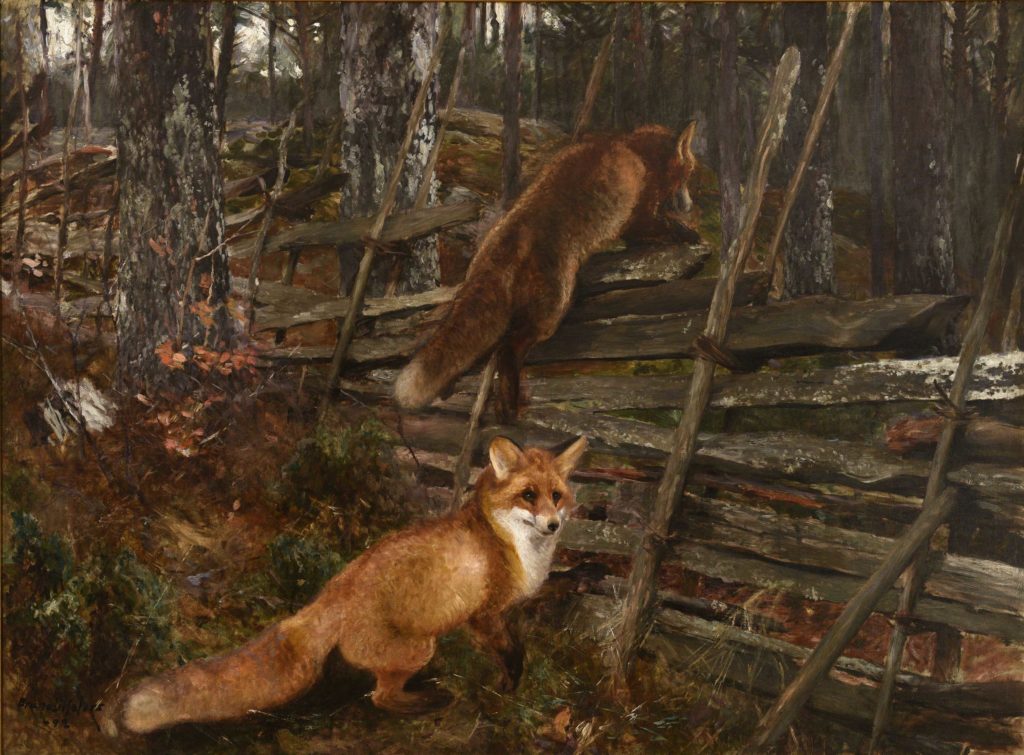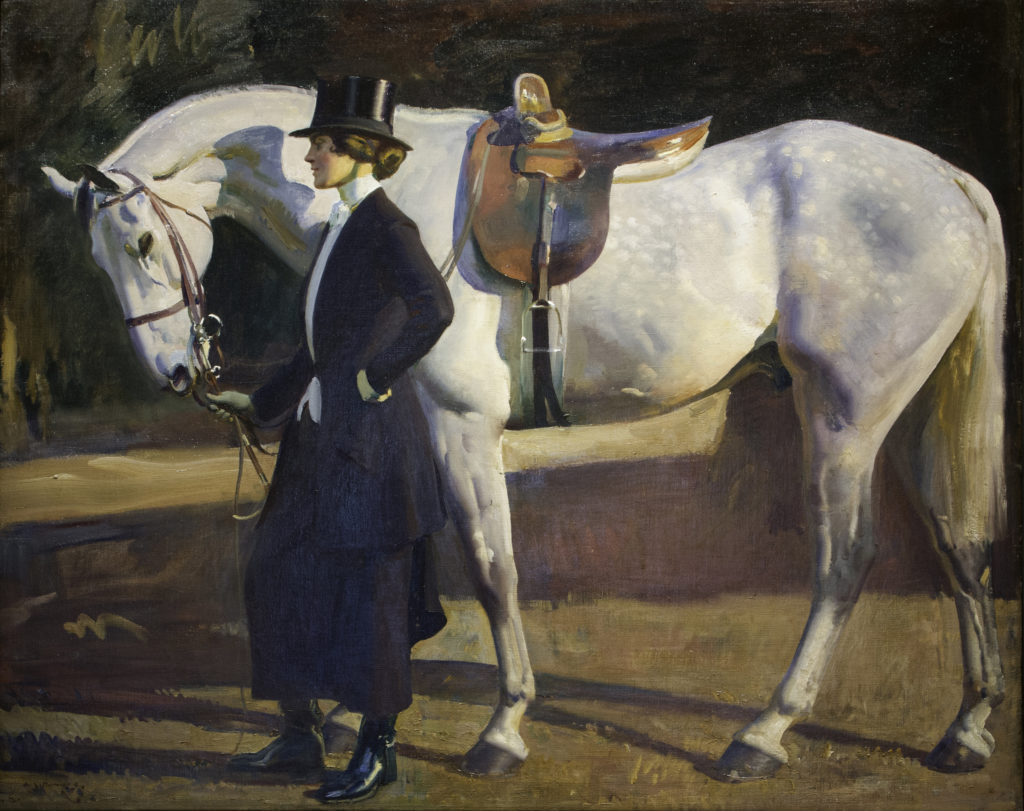Fine art is especially enjoyable when seen in beautiful surroundings. In November, I was invited to experience both of them in southwestern Georgia, a region I had never really noticed on maps before. My hosts were the proprietors of Pebble Hill Plantation, an estate open to the public and located five miles south of Thomasville, Georgia, and 22 miles north of Florida’s capital, Tallahassee. I was intrigued to learn that Pebble Hill holds a superb collection of sporting art, and is currently exhibiting 22 masterworks of wildlife art loaned by the Genesee Country Village & Museum in upstate New York. My curiosity was piqued, so I headed south to see for myself.
An Unusual History
When northerners like me hear the word “plantation,” we instinctively think of Gone with the Wind, but that is not actually Pebble Hill’s story. Established in the 1820s, the plantation weathered the Civil War and Reconstruction fairly well, but everything changed in and around Thomasville from the 1870s onward. Why? Because this town (current population, 19,000) was the terminus of the railway that brought well-heeled northerners south every winter, 20 years before the line was extended into Florida.

Fleeing cold weather, these tourists were charmed by the mild climate, rolling landscape, and longleaf pine forests of the Red Hills region, which extends southward from Thomasville to Tallahassee. They believed then that its pine-scented air helped people with pulmonary ailments, and they were astonished to learn that it was cheaper to buy land than to rent hotel rooms. As a result, Thomasville features several districts of grand Victorian mansions–think verandahs and gingerbread trim–built by these families, who socialized in town and hunted, fished, golfed, and raced horses in the surrounding countryside.
By the 1890s, the resort tourists realized they could afford to buy an entire plantation outside town, and that’s what happened at Pebble Hill. In the mid-1890s, it and several neighboring plantations were acquired by Cleveland industrialist Howard Melville Hanna (1840–1921), who moved in the same circles as John D. Rockefeller. These properties were ultimately transferred to Hanna’s various children. In 1901, Pebble Hill went to his daughter, Kate Benedict Hanna Ireland Harvey (1871–1936), who transformed it into a proper hunting retreat, and remained there until her death.

Her tenure overlapped with the heyday of America’s Gilded Age. Every year, from November through April, the family welcomed large parties of relatives, out-of-town guests, and neighbors for horse riding and well-organized hunts for bobwhite quail, duck, deer, dove, and turkey on their nearly 10,000 acres. (One hesitates to compare this scenario with Downtown Abbey, but there are parallels.) In 1914, a handsome loggia wing designed by the Cleveland architect Abram Garfield (son of President Garfield) was added to the main house. Ironically, it was the only portion to survive a disastrous fire in 1934.
Kate Harvey brought Garfield back to rebuild the main house. They completed their project in 1935, also the year she died. Its floor plan has remained the same since then, encompassing 26,000 square feet of living space spread over two floors. Kate Harvey bequeathed Pebble Hill to her daughter Elisabeth (“Pansy”) Ireland Poe (1897–1978), a nationally renowned equestrian, hunter, and breeder.

Partly because she was childless, Pansy decided in 1956 that the property would become a museum upon her death, and thus formed the Pebble Hill Foundation. The site opened to the public in 1983, five years after she passed, and now encompasses the main house, a large and impressive stable complex, and many event-rental and support buildings spread across 3,000 acres, most of them covered with pine forests. The public is welcome to explore 80 of these acres, which are impeccably manicured with plantings of live oak, magnolia, dogwood, azaleas, and wisteria.
Pansy Poe must have been an extraordinary person. In his book Pebble Hill: The Story of a Plantation, William Warren Rogers writes that she “was shy in the presence of crowds, but she had an Irish wit and temper . . . What mattered to her was preserving the beauty of Thomasville and Thomas County, and she led numerous battles to keep trees from being cut down, to restore historic homes, and to prevent the needless widening of streets. She often wondered aloud–in one of her favorite expressions–what was going to happen, “When I kick the bucket.” She needn’t have worried. The trustees and staff of Pebble Hill Plantation have kept it humming as a window on a slowly disappearing lifestyle of hospitality, good taste, and genuine engagement with nature.

Art Galore
Art lovers should particularly plan a visit because the house is filled with interesting paintings, sculpture, drawings, and prints, most related to nature and hunting. Mrs. Poe commissioned several artists to decorate specific rooms, and her guest book contains such leading names as Aiden Lassell Ripley (illustrated here is his painting of Pansy hunting turkey), Ogden Pleissner, Richard Bishop, and J. Clinton Shepherd.
The collection includes 33 works by John James Audubon, each depicting a bird that either lives in Georgia or migrates through it. For decades, Pansy Poe purchased sporting artworks from dealers and auctions in New York and London. She ultimately assembled a collection that emphasizes British artists, including Francis Sartorius, Charles Towne, Ben Marshall, George Armfield, John F. Herring, Jr., John Emms, John Charlton, Thomas Blinks, Walter Hunt, and Maud Earl, as well as American artists including Edward Troye, Arthur Tait, Edmund Osthaus, Lynn Bogue Hunt, Gene Pullen, Paul Brown, Tex Wheeler.
The jewel of her collection is Alfred Munnings’s masterpiece of 1922, “My Horse Is My Friend: The Artist’s Wife and Isaac” (above). Normally it hangs in glory upstairs in the Elisabeth Ireland Poe Gallery, which was created several years ago in a space once occupied by guest bedrooms. This season it has been returned to the main floor, where it glows among Mrs. Poe’s busy yet not over-cluttered décor, replete with antique furniture, porcelain, crystal, silver, glass, scrimshaw, horn carvings, arrowheads, and books.
The temporary exhibition “Wild in the Country” is on view in the gallery until April 29, and highlights four major artists represented in depth at the Genesee Country Village & Museum, Mumford, New York.
This article originally appeared in Fine Art Connoisseur magazine (subscribe here).
Sign up to receive Fine Art Today, the weekly e-newsletter from
Fine Art Connoisseur magazine.








Wow, that Munnings is magnificent!
[…] Sporting and Wildlife Art in South Georgia by Peter Trippi (preview the excerpt about Pebble Hill Plantation) […]